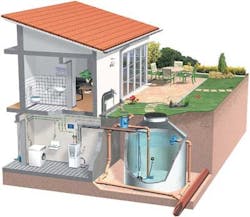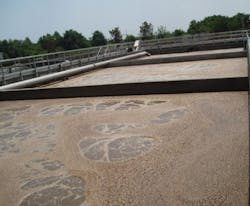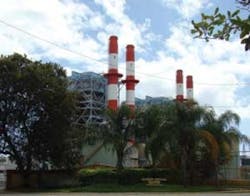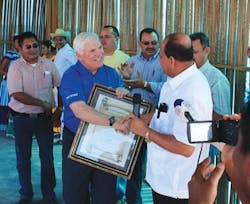Pump Performance Curve Shapes and How to Modify Them
By Allan R. Budris
As first pointed out in my September 2009 column, the Specific Speed of a pump dictates the shape of the head-capacity curve, with low Specific Speed pumps having flat or drooping H-Q curves, and high Specific Speed pumps having very steep curves. The pump shut-off flow brake horse power also increases with increasing Specific Speed values, exceeding the best efficiency flow input power requirements at "NS" values above about 4,500 to 5,000. At even higher specific speeds the H-Q curves can develop a dip which can further limit the minimum allowable flow rate.
Beyond the basic specific speed dictated performance curve shapes, there are times when, in order to better match the system performance requirements or improve the system efficiency, that modifications to an existing pump is a viable option. In my October 2009 column I discussed how to change the performance of a pump by trimming (or increasing) the impeller outer diameter. There are, however, times when changing not just the developed head but the shape of the "Head-Capacity" curve is desirable. Changing the H-Q curve shape may also be necessary to avoid a drooping curve to shut off for parallel operation (and/or for operation with a flat system curve), or to get the last bit of flow and/or efficiency from a particular pump, without replacing the impeller.
The three most common options for changing the shape of a performance curve (and/or moving the best efficiency flow point) are: removing metal from the outer periphery of the impeller vane tips; removing metal from the casing volute throat (tongue); and changing to an alternate impeller (not all pumps have this option) which has fewer (or more) vanes, larger or smaller discharge vane angle, and/or a wider or narrower impeller flow width.
Removing Metal from the Vane Tips
Pump performance is extremely sensitive to the shape of the impeller vanes, to the extent that even a deburring operation on the outer diameter can have a significant impact on the performance of a pump. This is also why replicated impellers often do not meet factory performance specifications, since the replicators may either not know the importance of, or have the ability to, exactly match the OEM impeller vane shape. This sensitivity can also be used by pump manufacturers, as well as users, to modify the performance of a pump after it has been built (without requiring a new impeller).
The most common impeller vane modification, to change performance, is to removing metal from the vane tips at the impeller periphery. Removing metal from the top (high pressure) side of the vane is known as overfiling. Removing metal from the under (low pressure) side of the vane is known as underfiling. The effect of overfiling on pump performance is very difficult to predict and/or to duplicate. This is because filing vanes by hand on the high pressure side changes the discharge angle of the impeller vanes in a non-uniform manner, so variation can exist between vanes. Occasionally pump efficiency can be increased slightly by overfiling with little change in total head.
"Underfiling" is more consistent, more predictable and easier to apply. It is most effective where vanes are thick and the specific speed is not too low. Underfiling increases the area and angle at the impeller discharge, thereby the capacity at peak is increased. This increase is directly proportional to the increase in area due to filing, or can be said to be equal to dimension "A" over "B" in figure 1. The capacity at the rated head will move to the right in a straight line to the new capacity, with a slight increase in efficiency, see figure 2. With underfiling, the shutoff head does not change, therefore, the change of performance by impeller underfiling is less effective to the left of peak efficiency. Underfiling is often used by pump original equipment manufacturers to meet guaranteed pump performance on the test stand. Basically it is compensating for manufacturing casing and/or impeller casting variances.
Removing Metal from the Volute Tongue
Capacity increase in a given pump can also be achieved by trimming the tip of the volute tongue in the pump casing throat. This is illustrated in Figures 3, with the impact on performance shown in Figure 4. Removing metal at this point increases the total volute throat area. To varying degrees, it is this casing throat area that regulates the pump flow rate. Pump efficiency at peak will, however, normally drop one or two points from this modification due to the resulting casing area mismatch with the impeller.
Low and High Capacity Impellers
Many pumps are offered with more than one impeller for a specific casing, to achieve a wider range of flow rates, and/or steeper or flatter head-capacity curve shapes for the same pump. The lower or higher capacities are achieved by designing impellers with narrower or wider flow passages, with greater or lesser numbers of vanes (figure 5), and/or steeper or shallower discharge vane angles. Greater numbers of impeller vanes, wider flow passages and steeper discharge vane angels all increase the flow rate (and the efficiency somewhat), but will also flatten the head-capacity curve shape. This could result in a drooping curve to shut-off on lower specific speed pumps.
Slope of Head-Capacity Curve
Further, the slope of the head-capacity curve can be increased by trimming the impeller outer diameter at an angle, with the resulting front shroud diameter being larger than the back (hub) shroud.
Finally, extending the impeller vanes further into the impeller eye can increase the slope of the head-capacity curve. An extreme version of this is the addition of an inducer in front of an impeller which will raise the pump shut-off head.
References:
"Pump User's Handbook - Life Extension", 3rd Edition, 2010, Allan R. Budris and Heinz P. Bloch, The Fairmont Press, Inc.
About the Author: Allan R. Budris, P.E., is an independent consulting engineer who specializes in training, failure analysis, troubleshooting, reliability, efficiency audits and litigation support on pumps and pumping systems. With offices in Washington, NJ, he can be contacted via e-mail at [email protected].
More WaterWorld Current Issue Articles
More WaterWorld Archives Issue Articles




